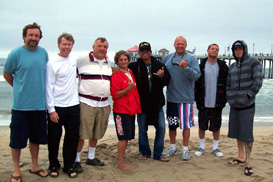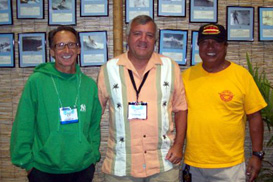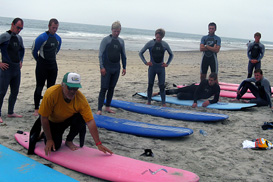 |
National Surf Schools & Instructors Association (NSSIA) | |||||||||||||
| The
Official Professional Association for the Surf School Industry Protecting Both Industry and Students • Established 2005 AN IRS REGISTERED NON-PROFIT ORGANIZATION |
||||||||||||||
|
||||||||||||||
|
||||||||||||||
| SURF NEWS | |
| A
Chunk of surfboard embedded in his face, blood pouring from his
wound and the sight in his left eye gone, Tom Palastanga battled
his way back to shore.
The 29-year-old geologist was enjoying an after-work surf at Maori Bay, near Muriwai, in good conditions and a 1m swell when disaster struck. He
had just caught his first ride and was on his way out for more when
he duck-dived a wave and did not see a surfer who was riding a wave
towards him. |
Surfing
horror: Man's face impaled By James Ihaka Wednesday Nov 17, 2010 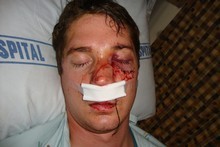
Tom Palastanga in his hospital bed after surgery to remove a piece of surfboard embedded in his face. |
"Usually
you can get out of the way, but it was like a split second ..."
he said.
"I just remember seeing him, his board and then the next few seconds just tumbling under the water with the boards and the leashes, thinking 'it's not a good situation'." Mr Palastanga, who moved to Auckland from Bridgend, south Wales, about two years ago, surfaced a few moments later. After getting his bearings and not feeling too much pain, he thought he might have escaped the encounter with a broken nose or grazes to his face. "I felt my face because I thought my nose might be a bit out of shape and then I felt this thing sticking out of my face - it was a good 20cm out of my face. "I realised then it was a bit of his board that had snapped off and was sticking out of my cheek ... it was pretty surreal, it was a horrible situation." A facial specialist later told him a chunk of the nose of the other man's surfboard had embedded itself at least 7cm into his face. The board smashed through his left cheek, fractured the floor of his left eye-socket and went through the sinus and Nasal cavity into the pharynx at the back of the throat. Blinded in his left eye, he could feel the piece of board in the roof of his mouth and blood trickling from the wound. Despite not being able to breathe properly, he was able to talk, and with the help of the other surfer, paddled back to shore. "The guy then ran off to call an ambulance and got his mate to stay with me," said Mr Palastanga. "We made our way up to the top carpark and shocked a few people on the way - it was a pretty horrific sight so I got someone to take a photo. "I was worried I was going to pass out, but I think it was the adrenalin that kept me going ... I was asking people how serious it looked and they all went 'yeah, it's pretty bad'." An ambulance took him to Auckland Hospital, where oral and maxillofacial surgeon Lance West was one of two specialists who spent 4 hours removing the piece of surfboard and rebuilding his eye socket. Mr West said the procedure was difficult because the broken bits of fibreglass and foam from the board did not show up on x-rays. The team could see the material in Mr Palastanga's head only because it was covered with a thin layer of blood that could be seen in the scan. He said Mr Palastanga was "a very lucky fellow" who had narrowly avoided being permanently blinded in one eye, severe nerve damage in his cheek and losing several teeth or worse. "He was lucky it had missed everything that was going to bleed and most of the nerves. A bit higher and he might have lost his eye but he has completely normal function there, lower and he would have damaged his teeth a lot," said Mr West. He would probably make a full recovery, apart from occasional numbness in his left cheek and permanent scar left by the 14 stitches inserted under his left eye. Mr Palastanga, who had his left eye-socket reconstructed with a titanium plate and screws and his nose put back in place after the incident three weeks ago, returned to his job in Albany last week. A surfer of 15 years, he says it has not put him off, "but it made me realise how bad it could have been and just how lucky I was." |
|
 |
Dangerous
staph germs found at West Coast beaches
By MARILYNN MARCHIONE, AP Medical Writer SAN FRANCISCO – Dangerous staph bacteria have been found in sand and water for the first time at five public beaches along the coast of Washington, and scientists think the state is not the only one with this problem. |
| The
germ is MRSA, or methicillin-resistant Staphylococcus aureus —
a hard-to-treat bug once rarely seen outside of hospitals but that
increasingly is spreading in ordinary community settings such as
schools, locker rooms and gyms. "We don't know the risk" for any individual going to a beach, she said. "But the fact that we found these organisms suggests that the level is much higher than we had thought." She presented results Saturday at an American Society for Microbiology conference in California. Last year, her team reported finding a different type of bacteria, enterococci, at five West Coast beaches. And earlier this year, University of Miami researchers reported finding staph bacteria in four out of 10 ocean water samples collected by hundreds of bathers at a South Florida beach. Many communities also commonly restrict bathing at beaches because of contamination with fecal bacteria. In the new study, researchers tested 10 beaches in Washington along the West Coast and in Puget Sound from February to September 2008. Staph bacteria were found at nine of them, including five with MRSA. The strains resembled the highly resistant ones usually seen in hospitals, rather than the milder strains acquired in community settings, Roberts said. No staph was found in samples from two beaches in southern California. People should not avoid beaches or be afraid to enjoy them, scientists say. "It's probably prudent to shower when you come out" to lower the risk of bacteria staying on the skin, said Dr. Lance Peterson, a microbiologist at NorthShore University Health System in Evanston, Ill. "Make sure you get all the sand off," and cover any open cuts or scrapes before playing in the sand, Roberts added. Digging in the sand or being buried in it seems to raise the risk of infection, she said. On
the Net: Microbiology meeting: http://www.icaac.org/ |
|
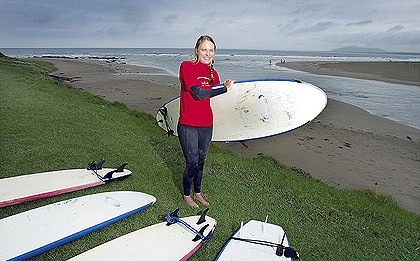 |
Trouble
in surfer paradise by Malcom Brown From the Sydney Morning Herald, January 24, 2010 The rising number of surf schools is causing flashpoints on crowded NSW beaches. Many of the state's councils are under pressure as a large and varied number of users - including boardriders, kayakers, divers, swimmers and surf skiers - place increasingly heavy demand on beaches. |
| Kiama Municipal Council wants to separate long-established surf schools at Seven Mile Beach, Gerroa, from recreational users who flock to the mouth of the Crooked River on the South Coast. There is more than 11 kilometres of beach stretching south, of which 1.8 kilometres is controlled by the council - but access is far more convenient at the river mouth. The proliferation of surf-school activities has been so disruptive that Kiama council has been forced to act, displaying a draft zoning plan for the beach. It will discuss the issue at its meeting on February 16. Surf schools and boot camps are commercial operations and councils are required to balance business use of the beach with that of other beachgoers. The director of planning for Byron Shire Council, Ray Darney, said licences clearly indicated which areas of the beach could be used for commercial activity, and it was necessary to separate the groups using the beach for safety reasons. But the managing director of Surf Camp surf school, Paul Vella, said that at Seven Mile Beach not enough people were using the surf for it to be an issue. ''On 90 per cent of the days there is nobody there. You could fire a cannon down the beach and not hit anyone. We are looking for 150 metres of beach or [we are] happy to have three zones of 50 metres. ''We have been operating at Seven Mile Beach since 2003 on licence from the Department of Lands. We have a lot more friends than we have enemies. Normally we have 30 to 35 people in the water. But over seven years we have operated here we have brought some 20,000 tourists to the district.'' Ron Williamson, a member of the Gerroa Community Service Association and representative of the longboard riders' club Malnutrition, said the issue was the concentration of the surf schools in the most popular area. ''There is access to other areas of the beach further to the south through a number of tracks. If tourists have come 20,000 kilometres to go to these surf schools, they can do another few hundred metres.'' Anthony Butcher, a proprietor of the Land's Edge Surf School, the other big surf school using the beach, said: ''There are a lot of interested parties down there. One issue might be access to the beach. Another might be location of the surf schools. There are a lot of people who care about the beach, and there are a lot of different concerns. ''I guess council is trying to work out the best way of managing a shared space. We have been there for 11 years and have a very good relationship with the council. We will just have to wait and see how it turns out.'' Blake Johnston, manager of the Cronulla Surf Academy, said surf schools were meticulous about not affecting other users on crowded beaches. ''We have been here seven years and we are training every school day through the summer period. We have a local plan that takes into account the other beach users.'' Craig Watchholz, general manager of Let's Go Surfing at Bondi Beach, agreed. ''We
have been here 15 years and there are lots and lots of other users.
There are two surf lifesaving clubs, swimming clubs, surf skiers,
ocean swimmers. We are privileged to be operating in a public space.
We have imposed limitations on our members to address those sorts
of things.'' |
|
| Older News Stories and Newsletters | |
| SURF NEWS | |
site map | contact | www.nssia.org
The National Surf Schools and Instructors Association (NSSIA) official website © 2005-2011 • All rights reserved
AN IRS REGISTERED NON-PROFIT ORGANIZATION
